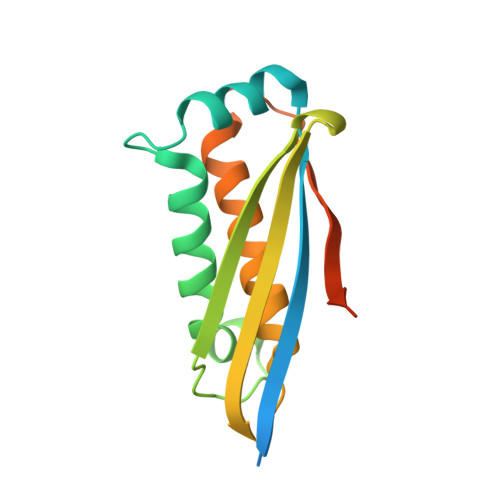Mechanism of pyranopterin ring formation in molybdenum cofactor biosynthesis.
Hover, B.M., Tonthat, N.K., Schumacher, M.A., Yokoyama, K.(2015) Proc Natl Acad Sci U S A 112: 6347-6352
- PubMed: 25941396
- DOI: https://doi.org/10.1073/pnas.1500697112
- Primary Citation of Related Structures:
4PYA, 4PYD - PubMed Abstract:
The molybdenum cofactor (Moco) is essential for all kingdoms of life, plays central roles in various biological processes, and must be biosynthesized de novo. During Moco biosynthesis, the characteristic pyranopterin ring is constructed by a complex rearrangement of guanosine 5'-triphosphate (GTP) into cyclic pyranopterin (cPMP) through the action of two enzymes, MoaA and MoaC (molybdenum cofactor biosynthesis protein A and C, respectively). Conventionally, MoaA was considered to catalyze the majority of this transformation, with MoaC playing little or no role in the pyranopterin formation. Recently, this view was challenged by the isolation of 3',8-cyclo-7,8-dihydro-guanosine 5'-triphosphate (3',8-cH2GTP) as the product of in vitro MoaA reactions. To elucidate the mechanism of formation of Moco pyranopterin backbone, we performed biochemical characterization of 3',8-cH2GTP and functional and X-ray crystallographic characterizations of MoaC. These studies revealed that 3',8-cH2GTP is the only product of MoaA that can be converted to cPMP by MoaC. Our structural studies captured the specific binding of 3',8-cH2GTP in the active site of MoaC. These observations provided strong evidence that the physiological function of MoaA is the conversion of GTP to 3',8-cH2GTP (GTP 3',8-cyclase), and that of MoaC is to catalyze the rearrangement of 3',8-cH2GTP into cPMP (cPMP synthase). Furthermore, our structure-guided studies suggest that MoaC catalysis involves the dynamic motions of enzyme active-site loops as a way to control the timing of interaction between the reaction intermediates and catalytically essential amino acid residues. Thus, these results reveal the previously unidentified mechanism behind Moco biosynthesis and provide mechanistic and structural insights into how enzymes catalyze complex rearrangement reactions.
- Department of Biochemistry, Duke University Medical Center, Durham, NC 27710.
Organizational Affiliation:


















